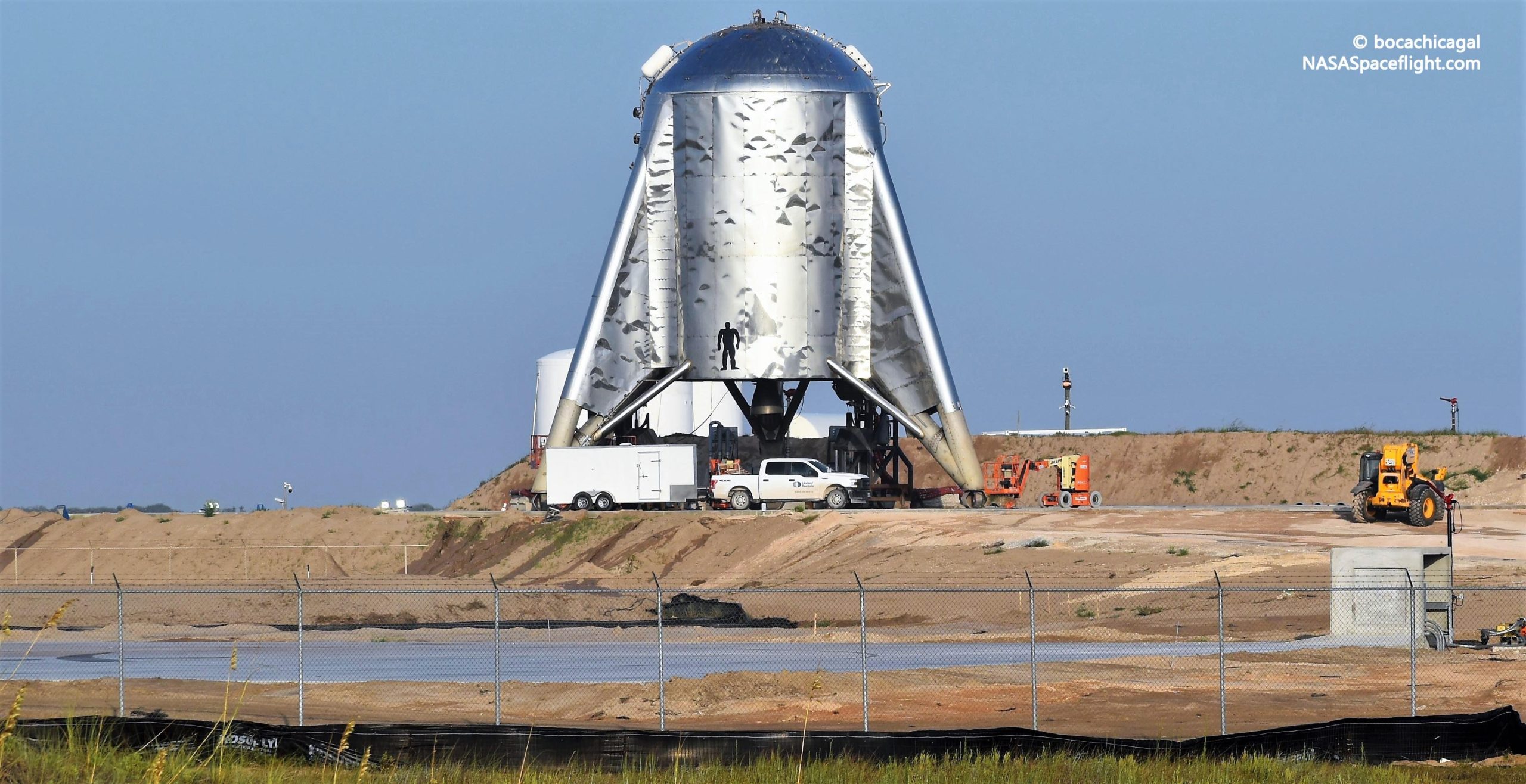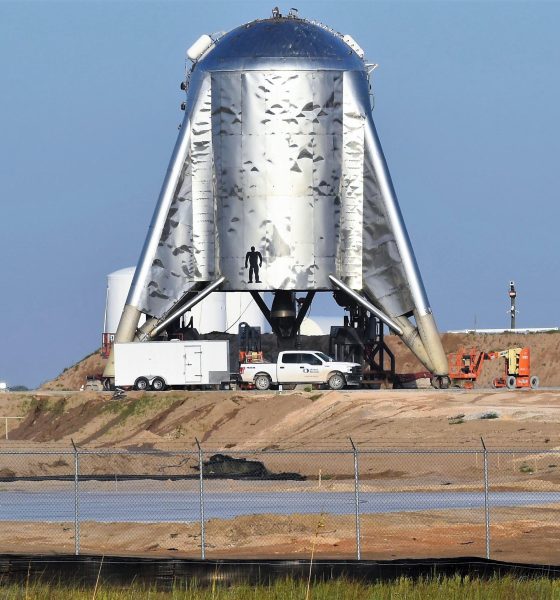

News
Livestream: SpaceX set for second Starhopper hop attempt after fixing Raptor bugs
SpaceX is reportedly ready to take a second stab at Starhopper’s second and final flight, rescheduled from August 26th to August 27th after an abort just milliseconds prior to Raptor’s main engine ignition.
According to CEO Elon Musk, that abort was automatically triggered by Raptor’s avionics when telemetry indicated an issue with the engine’s advanced system of torch igniters. Needed to safely start Raptor’s methane and oxygen preburners and ignite its the main combustion chamber, Musk believes that some relatively simple wiring issues in those igniters were to blame for Monday’s abort. As of this morning, Raptor’s igniters appear to have passed inspection and undergone any needed fixes and Starhopper is now scheduled for its 150m (500 ft) hop test no earlier than 5pm EDT (21:00 UTC), August 27th.
Updated August 27: (WATCH) SpaceX’s Starhopper hops itself into retirement after spectacular minute-long flight
Impressively accurate analysis!— Elon Musk (@elonmusk) August 27, 2019
Captured earlier today by visiting photographer Trevor Mahlmann, SpaceX technicians were observed working in and around Starhopper’s Raptor, the sixth such full-scale engine produced by SpaceX. One technician was seen literally inside Raptor’s nozzle, likely inspecting the business ends of the main combustion chamber’s igniters.
Head in the clou… thrust chamber, rather🚀
New igniters inbound? @elonmusk
⚙️/⬇️/🖼 : https://t.co/zWfJdm095L pic.twitter.com/fcmQwzEQWp— 📸Trevor Mahlmann🚀 (@TrevorMahlmann) August 27, 2019
During yesterday’s official SpaceX webcast, Starhopper aborted its hop test just milliseconds before main engine ignition, but Raptor SN06 appeared to briefly ignite one or both propellant preburners just prior to said abort. It’s unclear what exactly triggered the automatic abort, but preburner igniter issues would be far more challenging to repair in the field. SpaceX technicians could use fiber optic cameras to carefully inspect the torch igniters, but repairs would likely require a bit more work.
Live views of Starhopper test https://t.co/8ZFFFwErJF— SpaceX (@SpaceX) August 26, 2019
Should SpaceX choose to officially broadcast this second attempt, the company will post a link to the updated stream on its Twitter account. Yesterday’s tweet came roughly 10 minutes prior to Starhopper’s scheduled liftoff. Stay tuned for Starhopper’s second attempt at 5pm EDT.
If successful (and perhaps even if not), this flight test will be Starhopper’s last before retirement, making way for the first flights of Starship Mk1 and Mk2 prototypes in Texas and Florida.
Check out Teslarati’s Marketplace! We offer Tesla accessories, including for the Tesla Cybertruck and Tesla Model 3.

News
Tesla FSD fleet is nearing 7 billion total miles, including 2.5 billion city miles
As can be seen on Tesla’s official FSD webpage, vehicles equipped with the system have now navigated over 6.99 billion miles.

Tesla’s Full Self-Driving (Supervised) fleet is closing in on almost 7 billion total miles driven, as per data posted by the company on its official FSD webpage.
These figures hint at the massive scale of data fueling Tesla’s rapid FSD improvements, which have been quite notable as of late.
FSD mileage milestones
As can be seen on Tesla’s official FSD webpage, vehicles equipped with the system have now navigated over 6.99 billion miles. Tesla owner and avid FSD tester Whole Mars Catalog also shared a screenshot indicating that from the nearly 7 billion miles traveled by the FSD fleet, more than 2.5 billion miles were driven inside cities.
City miles are particularly valuable for complex urban scenarios like unprotected turns, pedestrian interactions, and traffic lights. This is also the difference-maker for FSD, as only complex solutions, such as Waymo’s self-driving taxis, operate similarly on inner-city streets. And even then, incidents such as the San Francisco blackouts have proven challenging for sensor-rich vehicles like Waymos.
Tesla’s data edge
Tesla has a number of advantages in the autonomous vehicle sector, one of which is the size of its fleet and the number of vehicles training FSD on real-world roads. Tesla’s nearly 7 billion FSD miles then allow the company to roll out updates that make its vehicles behave like they are being driven by experienced drivers, even if they are operating on their own.
So notable are Tesla’s improvements to FSD that NVIDIA Director of Robotics Jim Fan, after experiencing FSD v14, noted that the system is the first AI that passes what he described as a “Physical Turing Test.”
“Despite knowing exactly how robot learning works, I still find it magical watching the steering wheel turn by itself. First it feels surreal, next it becomes routine. Then, like the smartphone, taking it away actively hurts. This is how humanity gets rewired and glued to god-like technologies,” Fan wrote in a post on X.
News
Tesla starts showing how FSD will change lives in Europe
Local officials tested the system on narrow country roads and were impressed by FSD’s smooth, human-like driving, with some calling the service a game-changer for everyday life in areas that are far from urban centers.

Tesla has launched Europe’s first public shuttle service using Full Self-Driving (Supervised) in the rural Eifelkreis Bitburg-Prüm region of Germany, demonstrating how the technology can restore independence and mobility for people who struggle with limited transport options.
Local officials tested the system on narrow country roads and were impressed by FSD’s smooth, human-like driving, with some calling the service a game-changer for everyday life in areas that are far from urban centers.
Officials see real impact on rural residents
Arzfeld Mayor Johannes Kuhl and District Administrator Andreas Kruppert personally tested the Tesla shuttle service. This allowed them to see just how well FSD navigated winding lanes and rural roads confidently. Kruppert said, “Autonomous driving sounds like science fiction to many, but we simply see here that it works totally well in rural regions too.” Kuhl, for his part, also noted that FSD “feels like a very experienced driver.”
The pilot complements the area’s “Citizen Bus” program, which provides on-demand rides for elderly residents who can no longer drive themselves. Tesla Europe shared a video of a demonstration of the service, highlighting how FSD gives people their freedom back, even in places where public transport is not as prevalent.
What the Ministry for Economic Affairs and Transport says
Rhineland-Palatinate’s Minister Daniela Schmitt supported the project, praising the collaboration that made this “first of its kind in Europe” possible. As per the ministry, the rural rollout for the service shows FSD’s potential beyond major cities, and it delivers tangible benefits like grocery runs, doctor visits, and social connections for isolated residents.
“Reliable and flexible mobility is especially vital in rural areas. With the launch of a shuttle service using self-driving vehicles (FSD supervised) by Tesla in the Eifelkreis Bitburg-Prüm, an innovative pilot project is now getting underway that complements local community bus services. It is the first project of its kind in Europe.
“The result is a real gain for rural mobility: greater accessibility, more flexibility and tangible benefits for everyday life. A strong signal for innovation, cooperation and future-oriented mobility beyond urban centers,” the ministry wrote in a LinkedIn post.
News
Tesla China quietly posts Robotaxi-related job listing
Tesla China is currently seeking a Low Voltage Electrical Engineer to work on circuit board design for the company’s autonomous vehicles.

Tesla has posted a new job listing in Shanghai explicitly tied to its Robotaxi program, fueling speculation that the company is preparing to launch its dedicated autonomous ride-hailing service in China.
As noted in the listing, Tesla China is currently seeking a Low Voltage Electrical Engineer to work on circuit board design for the company’s autonomous vehicles.
Robotaxi-specific role
The listing, which was shared on social media platform X by industry watcher @tslaming, suggested that Tesla China is looking to fill the role urgently. The job listing itself specifically mentions that the person hired for the role will be working on the Low Voltage Hardware team, which would design the circuit boards that would serve as the nervous system of the Robotaxi.
Key tasks for the role, as indicated in the job listing, include collaboration with PCB layout, firmware, mechanical, program management, and validation teams, among other responsibilities. The role is based in Shanghai.
China Robotaxi launch
China represents a massive potential market for robotaxis, with its dense urban centers and supportive policies in select cities. Tesla has limited permission to roll out FSD in the country, though despite this, its vehicles have been hailed as among the best in the market when it comes to autonomous features. So far, at least, it appears that China supports Tesla’s FSD and Robotaxi rollout.
This was hinted at in November, when Tesla brought the Cybercab to the 8th China International Import Expo (CIIE) in Shanghai, marking the first time that the autonomous two-seater was brought to the Asia-Pacific region. The vehicle, despite not having a release date in China, received a significant amount of interest among the event’s attendees.








